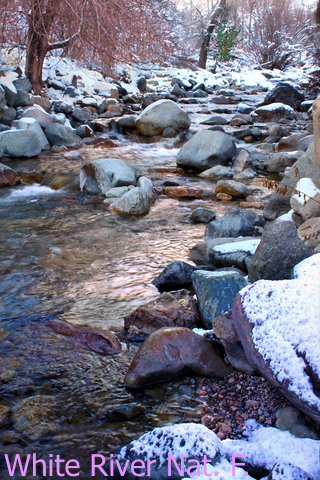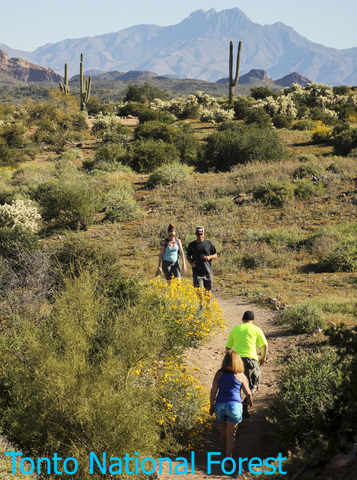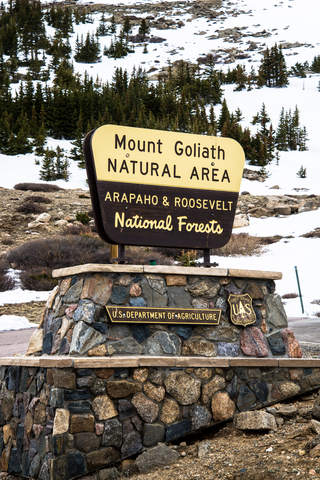Forest Service Map
This interactive map shows the Locations, Names, Area, and Uses of Public Lands managed by the United States Forest Service. Each polygon represents a Forest Service Unit. The border color represents the Land Use. The fill color represents the manager type. For more detail zoom in. For more information hover over the map, or scroll down.
| Land Use and Manager | |||
|---|---|---|---|
| Managed for biodiversity disturbance events proceed or are mimicked | Other | ||
| Managed for biodiversity - disturbance events suppressed | Forest | ||
| Managed for multiple uses - subject to extractive (e.g., mining or logging) or Off-Highway Vehicles | Grassland | ||
| No known mandate for biodiversity protection | |||
U.S. National Forests Map
This map shows the locations of US Forest Service sites. Because of the large number of sites and variety of uses, the sites were only classified into the 4 types shown above and depicted with different border colors.
The fill color was used to differentiate forests from grasslands from other manager types.
The types are not addressed directly, but each type covers some use, whether extraction, recreation, or biodiversity preservation.
Each use is addressed in one of the programs described below.
United States Forest Service

The United States Forest Service (USFS) manages an impressive 193 million acres (780,000 km2). This is equivalent to 8.5 percent of the country.
The national forest system was created in 1891 when president Benjamin Harrison signed the Land Revision Act.
This agency is not part of the Department of Interior like other Public Land management agencies, including National Parks, the U.S. Fish and Wildlife Service, and the Bureau of Land Management. The USFS is part of the U.S. Department of Agriculture.
The USFS manages 154 National Forests and 20 National Grasslands.
National Forests are often located near National Parks. They have multiple uses, including lumber, recreation, mineral extraction, and grazing. The different uses are depicted on the map.
The main priority of this agency is to "maintain and improve the health, diversity, and productivity of the nation’s forests and grasslands to meet the needs of current and future generations". USFS.
If you have decided to visit one of the National Forest sites, I suggest you pack these binoculars found on Amazon Gosky 10x42 Roof Prism Binoculars for Adults. They are HD Professional Binoculars for Bird Watching, Travel, and Stargazing. They come with a Lens Phone Mount and Strap Carrying Bag. They will help you experience the best of the National Forests.
National Park vs. National Forest
You are probably thinking National Forests are just another type of National Park. Still, there are a few differences between them:
| National Parks | National Forests |
|---|---|
| Highly focused on preservation | Focused in managing woodland resources and wildlife |
| Managed by the Department of Interior | Managed by the Department of Agriculture |
| Have Park Rangers | Have Forest Rangers |
| Area of 52.2 million acres | Area of 193 million acres |
| Limited hunting, camping, and campfires | Open to hunting, biking, and camping |
| Usually, charges fees | Usually free |
| 426 sites | 174 units for forests and grasslands |
No matter which destination you choose for your next camping trip. If you are out with friends or family, having a table always comes in handy, whether it is for meals or card games. This table found on Amazon: ALPS Mountaineering Dining Table will make the outdoors even more special to meet with your party.
National Forests Facts
- The Largest National Forest Local Manager is Tongass National Forest in Alaska. On the map, it is displayed as 19 wilderness areas that include Misty Fjords and Admiralty Island.
- The Nebraska National Forest is the largest man-made forest in the United States.
- The largest living organism is the Aspen Tree at the Fishlake National Forest in Utah. This organism clones itself and can grow over 5mi (8Km) long.
- The Humboldt-Toiyabe National Forest in Nevada is home to Bristlecone Pines Pinus longaeva. These trees reach 5,000 years. They are the oldest trees on Earth.
- The Oldest National Forest Local Manager is Shoshone National Forest in Wyoming. This forest was started as part of the Yellowstone Timberland Reserve in 1891.
- The state with the most National Forest land is Alaska, with 21.9 million acres.
- The state with the highest number of National Forests is California.
- El Yunque National Forest in Puerto Rico is the only tropical rainforest in the National Forest system.
- North Dakota and Kansas are home to National Grasslands but not National Forests.
- Some of our country's most popular ski areas with the best terrain are in National Forests. There are 135 Alpine Ski Areas in total.
- The USFS has 136 National Forest Scenic Byways.
- The Forest Service has 95 Wild, Scenic Rivers.
- There are over 6,709 miles of Scenic and Historic Trails.
- The annual number of National Forest Visits is 205 million.
- The Forest Service manages 7 National Monuments, Volcanic Monuments, and National Preserves.
- There are 122,000 campsites in the National Forest Service. USDA
- The National Forests contribute $13 billion annually through visitor spending. Source: Nationalforests.org


These are all fantastic sites to visit, but because many paths will have uneven terrain, I suggest you use these boots found on Amazon. They will provide comfort while you reach your destination. Merrell Moab 2 Mid Waterproof Hiking Boot.
The Best National Forests
This list includes the most searched National Forests in the U.S. in the last 5 years on Google Trends.
- Shawnee National Forest, Illinois: This forest has rolling hills, open lands, creeks, bluffs, cliffs, sandstone formations, views, and a rocky bridge. Visitors can walk through canyons under the forest canopy.
- Pisgah National Forest, North Carolina: Is home to the first U.S. forestry school, mile-high peaks, waterfalls, forested slopes, whitewater rivers, and hardwood forests. All this with hundreds of miles of hiking trails for visitors to explore.
- Ocala National Forest, Florida: Features more than 600 lakes and rivers fed by springs. Visitors can swim or canoe while viewing rare plants, birds, and manatees!
- Angeles National Forest, California: Close to Los Angeles and prone to fires, this forest has different majestic peaks, with pines, fir, high desert, snowy mountains, and rivers.
- Sequoia National Forest, California: Unlike Sequoia National Park, next to it, this site is open to logging. Named for the world's largest trees, it has the greatest concentration of giant sequoia groves worldwide.
- Tonto National Forest, Arizona: This is a rugged area in the Sonoran Desert. The cacti give way to highland and cool pine forests.
- Los Padres National Forest, California: This forest is North America's only biodiversity hotspot, with rich and endangered ecoregions. The marine coastline meets redwood forests, grasslands, oak woodlands, chaparral, semidesert scrub, and conifer forests.
- Mark Twain National Forest, Missouri: Mostly within the Ozark highlands, the Forest is characterized by permanent springs, caves, rocky barren glades, and old volcanic mountains.
- Allegheny National Forest, Pennsylvania: Pennsylvania’s only National Forest, in the foothills of the Appalachian mountains, is composed of plateau tops and valleys. This forest captures the ideals of a National Forest. It provides wood products, watershed protection, various wildlife habitats, and recreational opportunities.
- Coconino National Forest, Arizona: "The Coconino National Forest is one of the most diverse National Forests in the country with landscapes ranging from the famous red rocks of Sedona to Ponderosa pine forests, from southwestern desert to alpine tundra.


Most Visited National Forests
These are some of the most visited forests in the USA. Source: USDA

- White River National Forest in Colorado has the most visits with 9.7 million visitors; 6.5 million of these visits are from skiers.
- Arapaho Roosevelt in Colorado receives 6 million visitors (not including skier visitors).
- Tonto National Forest in Arizona receives 5.9 million visitors (not including skier visitors).
- National Forests in North Carolina
- Wasatch-Cache National Forest in Utah.
- Mt. Baker-Snoqualmie in Washington.
- Mount Hood in Oregon.
- Superior National Forest in Minnesota.
- Inyo in California.
If these locations help you choose a destination for camping, you will probably want a bit more comfort while you spend the night outdoors. You might be interested in this sleeping pad from Amazon: WELLAX Ultra thick FlexFoam sleeping pad. It is a self-inflating 3 inches thick, warm, camping mat, ideal for backpacking and hiking in the National Forests.
Forest Management
The National Forest was created with various objectives. These included secure watershed conditions, protecting the forest, and supplying timber for US citizens.
The objectives of the USFS have evolved. Now they are focused on sustaining the forests and the grasslands. Timber sales and removal of forest products to support resilient and adaptive ecosystems. Also, to mitigate climate change and wildfire risk. Forest Service
Camping in the National Forest

Like other public lands, the best way to plan your camping in a National Forest is through the Recreation.gov website.
There are over 122,000 campgrounds in the National Forests, and the fee is usually small. On the other hand, Dispersed camping is generally free and almost limitless in the number of locations you can choose.
Dispersed Camping is quite popular in the National Forests. But, you cannot camp just anywhere. You have to follow the rules for the area and camp where there are outlines of previous camping.
Remember to stop by the ranger station to get information, arrive before dark, avoid popular seasons like summer, and leave no trace!
National Forest Camping usually has a maximum of 14 days, but popular forests can decrease this time.
For an adventure outdoors in mild conditions and with a small family, I recommend this tent found on Amazon Coleman 6-Person Dark Room Sundome Tent. It is not expensive, and it will protect you from the elements.
National Forest Programs and Products
The National Forests are important not just for the recreation they provide but for the science, products, and research they initiate.
Concerning wildlife, the NFS restores aquatic ecosystems and the habitats of black bears, frogs, bighorn sheep, and hummingbirds.
The National Forest Service manages valuable products from its forests. These include paper, packaging, lumber for construction, renewable energy materials, wood for furniture, and structural material for bridges and transportation.
The USDA Forest Products Laboratory in Madison WI conducts research that focuses on forest advanced structures, biorefinery, nanotechnology, and woody mass.
The Forest Service has a strategic framework to care for the environment and find alternative sources of renewable energy. They are currently working on becoming energy neutral. FS Science.
The National Forest has a Minerals & Geology Management Program ((MGM) that manages geologic and mineral resources. Mineral commodities from Forest lands include gold, silver, copper, platinum, palladium, lead, zinc, sand, gravel, coal, gas, phosphates, and oil.
MGM also administers caves, paleontological, fossil resources, and abandoned mines.
Sources to Make U.S. Forest Service Map
The shapefiles to make the states were downloaded from Natural Earth
The shapefiles used to make the forest polygons were downloaded from USDA
The general guide to making this map is found in Let's Make a Map.
This map will be updated with new data! To receive updates on this and more nature maps, join my email list!!!!!!!
Made by Luz K. Molina with D3.js.






